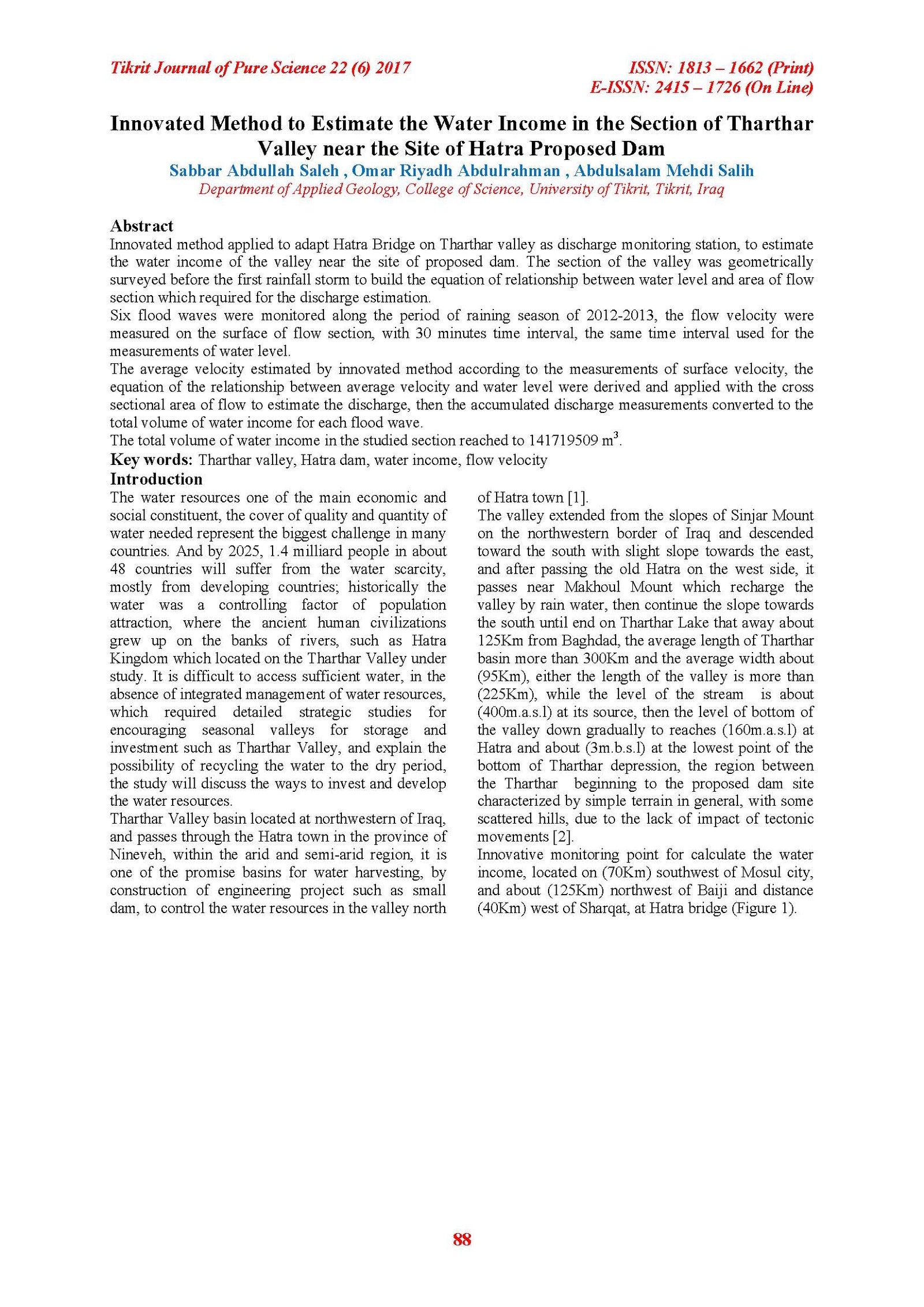Innovated Method to Estimate the Water Income in the Section of Tharthar Valley near the Site of Hatra Proposed Dam
Main Article Content
Abstract
Innovated method applied to adapt Hatra Bridge on Tharthar valley as discharge monitoring station, to estimate the water income of the valley near the site of proposed dam. The section of the valley was geometrically surveyed before the first rainfall storm to build the equation of relationship between water level and area of flow section which required for the discharge estimation.
Six flood waves were monitored along the period of raining season of 2012-2013, the flow velocity were measured on the surface of flow section, with 30 minutes time interval, the same time interval used for the measurements of water level.
The average velocity estimated by innovated method according to the measurements of surface velocity, the equation of the relationship between average velocity and water level were derived and applied with the cross sectional area of flow to estimate the discharge, then the accumulated discharge measurements converted to the total volume of water income for each flood wave.
The total volume of water income in the studied section reached to 141719509 m3.
Article Details

This work is licensed under a Creative Commons Attribution 4.0 International License.
Tikrit Journal of Pure Science is licensed under the Creative Commons Attribution 4.0 International License, which allows users to copy, create extracts, abstracts, and new works from the article, alter and revise the article, and make commercial use of the article (including reuse and/or resale of the article by commercial entities), provided the user gives appropriate credit (with a link to the formal publication through the relevant DOI), provides a link to the license, indicates if changes were made, and the licensor is not represented as endorsing the use made of the work. The authors hold the copyright for their published work on the Tikrit J. Pure Sci. website, while Tikrit J. Pure Sci. is responsible for appreciate citation of their work, which is released under CC-BY-4.0, enabling the unrestricted use, distribution, and reproduction of an article in any medium, provided that the original work is properly cited.
References
[1]Salih, S., Kadim, L. and Qadir, M. (2012) Hydrochemistry as Indicator to Select the Suitable Locations for Water Storage in Tharthar Valley, Al-Jazira Area, Iraq. Journal of Water Resource and Protection, 4, 648-656. doi: 10.4236/jwarp. 2012. 48075.
[2]Ruddiman, W.F. (ed.), 1997.Tectonic Uplift and Climate Change, Plenum Press, New York.
[3]Fathallah, M. F., (1977). Hydrological study of the Tharthar river basin and the possibility to take advantages of the water for develop the Al-Jazera area, the Journal of Iraqi Geological Society, Vol. 10, pp. 1-12.
[4]Araim, Hakki, (1983). Hydrogeology of the Jezira desert D.G. of geological survey and mineral investigation, Baghdad, p 19.
[5]Almuhsin, S. Y., (1985). Groundwater and Investment in Sinjar area. M. Sc. Thesis, Baghdad University. Collage of Art. 302 page.
[6]Al-Moula, M. F. M., (2002). Morphometric Study for Specifying Location of Dam in Wadi Al-Tharthar Basin north of Hatra Using Remote Sensing Techniques, M.Sc. Thesis, University of Mosul, Mosul.
[7] Al-Dulaimy, Y. H. M., (2005). Mathematical model of unconfined aquifer in northern part of Tharthar basin, department of geology, college of science, University of Baghdad, M.Sc. thesis (unpublished), 79p.
[8]Khattab, M. F., (20050 Hydrogeomorphological and Quantity Study for Tharthar Valley, Northwest Iraq, Rafidain Jour- nal for Science, Vol. 16, No. 2, pp. 50-61.
[9] Al-Jubouri, M. A. Al., (2011). Evaluation of hydrogeological conditions, and build the mathematical model of the groundwater reservoir in the site of Hatra proposed dam, department of applied geology, college of Science, University of Tikrit, M.Sc., 170p, (unpublished).
[10] Mohammed, M. S., (2011), Geotechnical evaluation of rocks in Tharthar valley near Hadhar city, northeastern Iraq for construction a dam, department of applied geology, college of science University of Tikrit, M. Sc. Thesis (unpublished), 131p.
[11] Al-Sayyab, A. S., Al-Ansari, N., Al-Rawi, T. Al-Jassim, J., Al-Omari, F., and Al-Sheikh, Z., (1982). Geology of Iraq, Mousul University Press, 280p.
[12]Jassim, S. Z., and Goff, J. C., (2006) Geology of Iraq, Dolin, Prague and Moravian Museum, Brno.
[13]Awwad, J. H., (1984). Hydrogeology of southern Sinjar mount, with a mathematical model of the plain, department of geology, college of Science, University of Mosul, M. Sc. Thesis (unpublished), 177 p.
[14] Al-Naqqash, A. B., Ismail, S. K., Hassan, H. A., and Rahi, K. M., (2003), Study of evaluation and suggest operating program for the international project for drilling groundwater wells in Kirkuk governorate, and the future expansions, ministry of irrigation, general directorate of groundwater wells drilling.
[15] Al-Omari, F., and Sadiq, A., (1977), Geology of Northern Iraq, National library, Baghdad, 198p.
[16] Al-Badri, A. S., Ahmed, A. I., and Marqus, S. S., (1985). Final report about the salts sediments in Samawa area, GEOSURV, internal report, 193p.
[17] Al-Mashhadani, A. A. M., (2000). Geophysical evidence of subsurface structures for Al-Jazera area, western Iraq, department of geology, College of Science, University of Mosul, PhD thesis (unpublished), 221 p.
[18]Al-Babwati, A. A. H., (1991). Terrain Elements of Tharthar Valley, Department of Geography, College of Arts, University of Baghdad, M.Sc. Thesis, (280p), (unpublished).
[19]Laat, P.J.M. and Savenije, H.H.G., (2002). Hydrology, Lecturer notes, LN0262/06/2, 120pp.
[20] Raghunath, H. M., (2006). Hydrology, Principles, Analysis and Design, New Age International (P) Ltd., Publishers, 4835/24, Ansari Road, Daryaganj, New Delhi – 110002, India, 2ndedition, 463pp.
[21]Shaw, E. M., (2005). Hydrology in Practice, Taylor & Francis e-Library, 3rd edition, 613pp.
